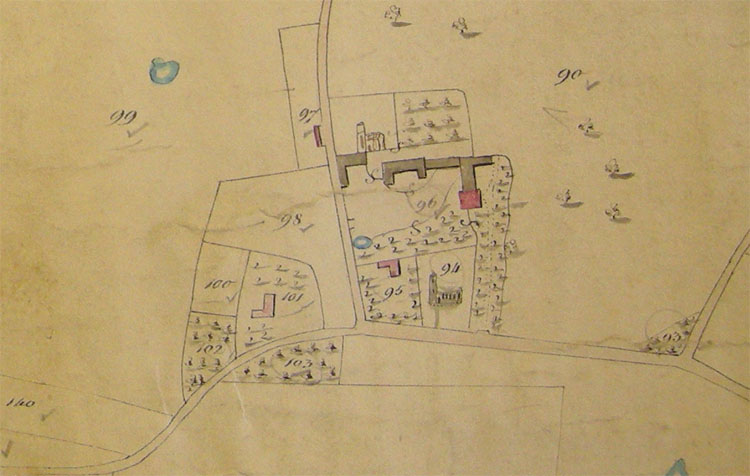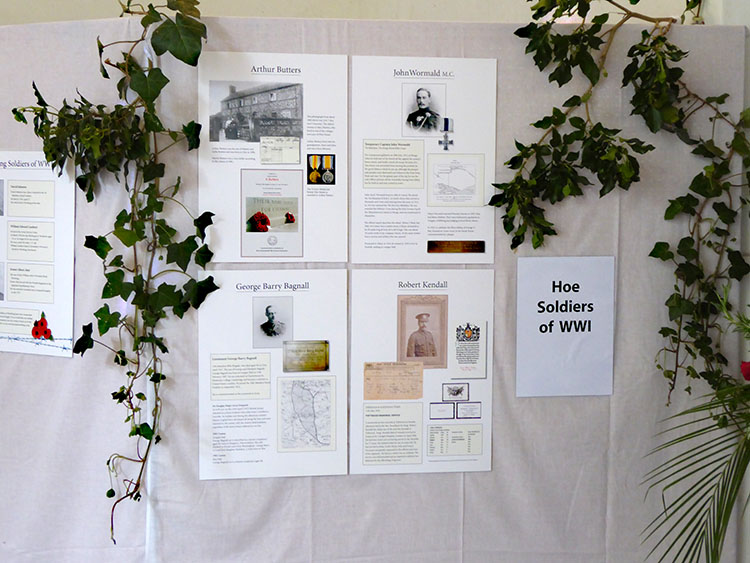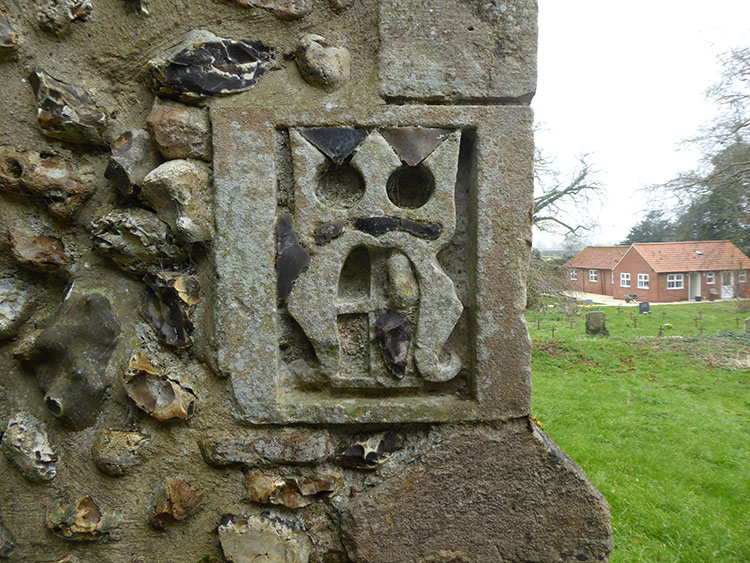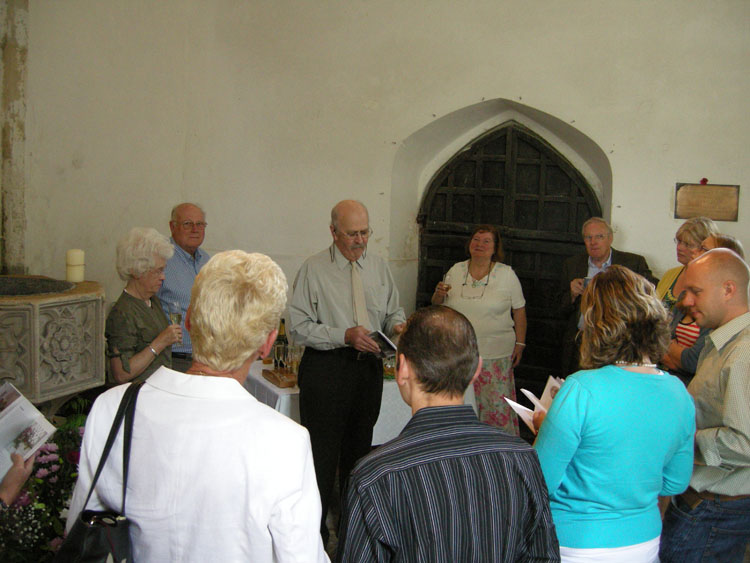|
|
| Contents Ladbrooke 19th-century maps Terrier of furnishings Memorials The font The Customs of Hoe Tithes A fragment of the old church Benjamin Armstrong Mormons Robert Barker Fund-raising and the tower Mothers’ Union History The churchyard |
 Hoe church was extensively rebuilt in the eighteenth and nineteenth centuries on a much reduced scale, without aisles, having fallen into a bad state of repair. This Ladbrooke lithograph is from 1823 when the road ran between the church and the hall. The belfry windows were added the same year. In 1960 Dr Eric Puddy, who lived at the Mill House, wrote a short history of the church. Dr Puddy quotes an entry in the churchwardens' accounts which reads '1794 May 16th. Paid the expense at Dearham when the church was put out . Five shillings.' and he concludes that there had been a fire at the church requiring the attandance of a fire engine. Had the fire caused sufficient damage as to require its rebuilding? Download pdf 19th-century maps  The old route of the road is shown on the enclosure map of 1814. [Courtesy of Norfolk Record Office C/Sca/2/243]  The tithe map surveyed in 1847 shows the present route. [Courtesy of Norfolk Record Office BR 276/1/119]  This terrier dated September 30 1716 lists the church furnishings: A true and perfect Account of all ye Goods, Books, Ornamts & Utensils belonging to ye Church of Hoe in ye County of Norfolk & Diocese of Norwich. Imprimis One pewter fflaggon Three Bells One silver Chalice wth a Cover. weighing 14 ounces One Carpet for ye Comunion Table One Pulpit Cloth & Cushion of ye same One fine Linnen Cloth for ye Comunion Table One Surplice of Holland Two Comon Prayer Books John Oxwick One large Bible Churchwardens The book of Homilies, & Bishp Jewell Robert Herring [Courtesy of Norfolk Record Office DN/TER 86/1/3]  In June 1894, George Bagnall lived at Gorgate Hall, and at Hoe Hall from about 1900.  March 1948. Francis Blomefield and Charles Parkin's An Essay towards a Topographical History of the County of Norfolk (1739-1775) contains this description of Hoe church: To this hamlet belongs a chapel with a nave or body, a north and south isle, and a chancel covered with lead, with a square tower and 3 bells; and the cure is served by the vicar of East Derham.  On another, [the photograph above shows what remains] In the north isle at the east end, was a chapel; in the window, argent, a lion rampant, sable, crowned, or, Morley; also the figures of a person lying as dead on an altar tomb, and 5 priests as praying by him, in a north widow; in the east window of the said isle is a representation of the crucifixion; and here was probably a clerk's chantry, there being at the bottom of the said window,  And on a mural monument against the east wall here [photograph above, the monument is now on the north wall], the arms of Lestrange.  This tomb slab in the nave floor isn't mentioned in Blomefield, despite being of sufficient age. Perhaps the delightfully amateur inscription and its commemoration of a yeoman farmer, William Blackhall, were reasons for its having been omitted. George Carthew's The Hundred of Launditch (1877) gives this description of HOO CHURCH: The interior of this has been during the last year much improved for divine worship; a horrid old deal pulpit and desk, with square boxes of all heights and sizes, having been removed and replaced by uniform open seats of pitch pine, pulpit of the same material, and lectern. The erection, however, of similar choir seats in the chancel has been the means of cconcealing several inscribed slabs which were in the floor when I copied them thirty or forty years ago. Those copies, I regret to say, I have mislaid and am unable to give. At the earlier time I mention the marble slab with Orate for John Dunham de Hoo, &c., the inscription of which is given in Blomefield (x. 51), was built, part of it, into one of the butresses to the north wall, and there remains.There is no evidence of this memorial now but the remains of another memorial still visible, with the date April 1622 (photo below), built into the north wall, may refer to Margaret Utber whose date of death coincides, listed by Blomefield (see above) and said by Carthew to have disappeared.  On the north wall this stone bears the date April 1622. The rest of the text is indecipherable.  In May 2014, to commemorate the servicemen from Hoe who served with distinction or were casualties of the First World War, an exhibition was held in the church.  George Bagnall was born at Gorgate Hall in 1887 and became a solicitor in London. He died at Arras.  Pilot Officer James Arthur Barclay died on 8th December 1941 and is commemorated at the Runnymede Memorial. Charles James Taylor was the son of Charles George and Lucy Taylor (of Gressenhall), husband of Elsie Taylor. He died aged 26 on 3rd March 1945 and is buried in Uden War Cemetery in Holland. His brother, Allured John, died aged 21 on 24 January 1942 in Singapore and is buried in Kranji War Cemetery.  Few of the features described in Blomefield survived the rebuilding. The 15th-century font stands on four octagonal stones which could well be from the shafts of the demolished nave arcade pillars.  This document, 'The Customs of the Towne of Hoe…', is dated 1614 and lists the tithes due from parishioners to the Rector. These tithe customs were endorsed in 1723 by the then Rector and churchwardens, W. Leach, William Cobb, Robert Herring and William Foulgier. [Courtesy of Norfolk Record Office DN/TER 86/1/4] In 1806 a later copy transcribed the terrier as follows:   An Act of Parliament in 1836 commuted payment of tithes in kind into cash. Surveys of land, with maps, were produced as an assessment of value. In Hoe the survey was made in 1847 and sealed by the government commissioners the next year.  [Courtesy of Norfolk Record Office BR 276/1/119] On the tithe map the fields are numbered to refer to the survey list. Here is the entry for Spring Farm, where James Fellows was the tenant of the landowner, Edward Lombe, and was assessed on his acreage (3 rods, 7 perches) at 1s. 6d. At Manor Farm, Samuel Norton had to pay £53 5s. 7d on 249 acres, 2 rods, 8 perches.  [Courtesy of Norfolk Record Office BR 276/1/119]  Among the few remaining traces of the medieval church from before its rebuilding is this flushwork crowned monogram M. The M symbol in the pre-Reformation church denoted Mary, and possibly in this case may also refer to the Morley family, sometime lords of the manor of Swanton Morley, whose coat of arms appeared in a window until the rebuilding.  The south porch was restored in 1999. The initials WG are most likely to be those of William Grounds who lived at Hoe Hall. Did he build or restore the porch at the same time as realigning the road to the south of the church, as appears from the maps above?  Revd Benjamin Armstrong
was vicar of East
Dereham,
Revd Benjamin Armstrong
was vicar of East
Dereham, including Hoe, from 1850 to 1888. His diaries include many entries describing events in the village, such as these from December 1st 1857 and March 18th 1877. Had a good gallop on a hired pony with my Newfoundland galloping alongside, to Hoe, where visited Mrs Norton & Mrs Blomfield who is likely to die, & like too many prefers the ministrations of the Vicar to that of a curate. Explained to her that all priests are equal & she promised to receive the curate in future. Preached for the last time from the old 'three-decker' pulpit in Hoe Church, the churchwardens having erected a new pulpit near the chancel steps. When a huge sounding board was removed, the iron by which it was suspended over the head of the preacher was found to be worn away to a mere thread which might have given way at any moment.  This little mustard-pot lid came from Dereham Vicarage. Peggy Butterfield, who lived at Spring Farm, Hoe, until 1978, was given it by her aunt, Elizabeth Barker, who worked at the Vicarage.  In March 1851 a census was conducted of churches and their congregations. Armstrong describes the church as a 'Chapel … annexed to the Parish of East Dereham' and gives the numbers of attendees at morning and afternoon services. Crown Copyright HO-129-242_3 On September 24th 1852, Armstrong visited Hoe's thirty-four poor families, all of which possess a copy of the Holy Scriptures, and are all baptized. The whole of them belong to the Church, except two families who are Mormonites… . Dereham's branch of the Mormon church was founded on 24th March 1849.  1861 census for Hoe. Jeremiah Jones (the younger), his wife and children were one of those Mormon families. They emigrated to America in 1862, by then with three children, sailing from Liverpool to New York.  Robert
Barker (1830-1904)
was Parish Clerk
for thirty years.
He worked as a
farm labourer. Robert
Barker (1830-1904)
was Parish Clerk
for thirty years.
He worked as a
farm labourer. Excerpt from the will of Thomas Warner of Hoe, dated 1558, in which he leaves a sum of money '… to the reparacion of the the steple in Hoe …'. Evidence that the problems with the tower go back a very long way. National Archive PROB-11-42B-421  So far as we know, this is a unique photograph of the church showing the tower in its taller state before it was damaged in a storm and subsequently rebuilt to its present height. The line of a much steeper roof can be seen on the tower.  In the early
years of the twentieth
In the early
years of the twentieth
century fund-raising events were held in aid of the rebuilding of the tower. In June 1907, this bazaar was 'a dazzling spectacle'.  Nearly £50 had been raised by August 1907. Who paid the remaining amount is unknown, but when work started the tower fell again, apparently caused by weak foundations, and the fund was used instead to build the parish hall, which opened in 1912.  The tower was rebuilt in its present form, ending below the line of the nave roof. A single bell was rehung.  This letter is
from Patience
Puddy, wife
This letter is
from Patience
Puddy, wife of the local doctor, Eric Puddy, to Grace Kenny about her mother, Emma Dawson (see 8-9 Hoe). In 1959 a new banner for the Mothers' Union was to be dedicated, along with an offertory bag in Mrs Dawson's memory.    Emma Dawson's grave at her funeral in 1958.  Hoe resident Dr Josephine Lloyd wrote and published a history of St Andrew's church in 2010. Among those present at the launch were (left to right, from the font) Jenny Tuckwell, Ernie Lloyd, who took the photographs for the book and John Tuckwell, churchwarden. Josephine Lloyd is standing in front of the door.  In 1954,
Bunnings of
Gressenhall
made this iron
gate
In 1954,
Bunnings of
Gressenhall
made this iron
gate for the churchyard. David Bunning's grandfather George was photographed at its installation (we have not yet found this photo, sadly). In 2010 David (left) refurbished the gate in his grandfather's memory and is photographed here with Charles Carey, then the churchwarden who looked after the churchyard.  The cherry trees, which were planted for the 1977 Silver Jubilee, looking spectacular. Cliff Hudson took the photo while his dogs waited.   In 2016, John Tuckwell remade the wooden crosses marking graves in the church yard extension. The originals had rotted and some of their positions were uncertain. Surveys made in the 1970s by the Swanton Morley Family History Group were consulted to establish the names of the interred, among whom was Emma Dawson. |
|